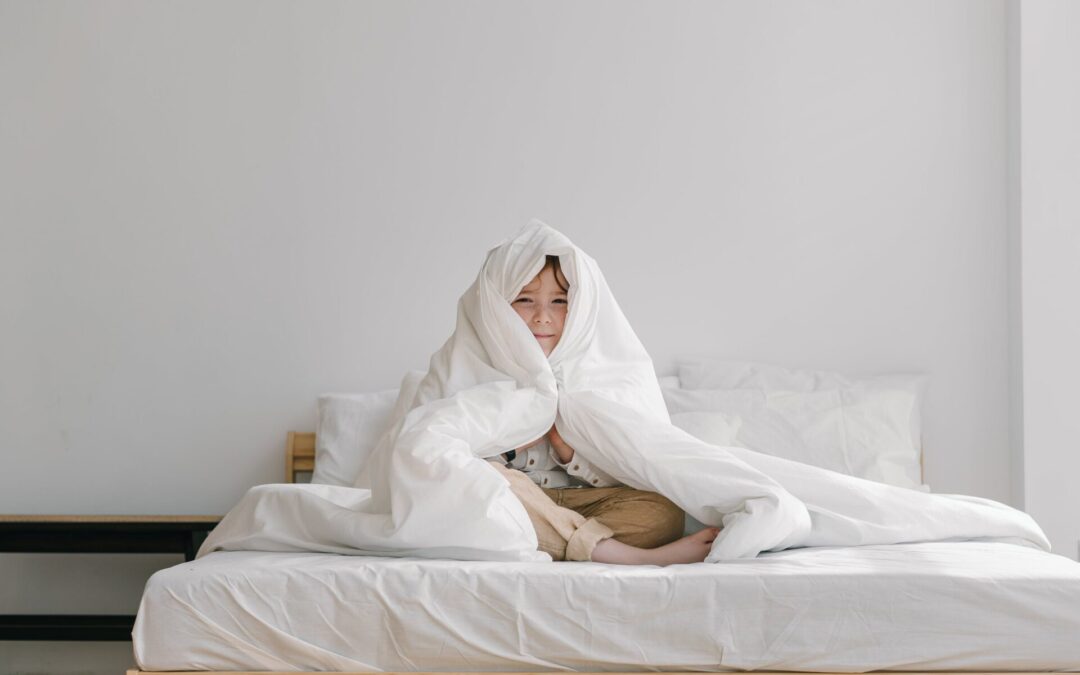Read our buying guide for tips to help you make an informed decision when shopping for children’s mattresses. Also, discover more about the importance of sleep on child development.
How does sleep impact child development?
Quality sleep is crucial and plays a vital role in a child’s physical and mental development.
- Physical growth: Growth hormones are mainly secreted during deep sleep, so sleep is critical for a child’s physical development. Quality sleep helps your child’s body repair and regenerate cells, which is essential for growth and development.
- Cognitive development: Getting enough sleep is crucial for a child’s brain development, which involves learning, memory, and attention. Sufficient rest can help a child stay alert and focused, which may improve their academic performance.
- Emotional regulation: Adequate sleep is vital for a child’s ability to regulate their emotions, which is essential for their mental well-being. Not getting enough sleep can lead to mood swings, irritability, and difficulty controlling emotions.
- Immune system function: Getting enough quality sleep can boost your child’s immune system. During sleep, their body produces proteins called cytokines, which can aid in fighting infections and inflammation.
- Overall health: good sleep is necessary for maintaining overall health and well-being. On the other hand, poor sleep has been associated with health problems such as obesity, diabetes, and cardiovascular disease.
Prioritising children’s sleep and providing a safe, comfortable environment is crucial for quality sleep.

Airsprung Eco Nightlight Kids Mattress
The Airsprung Eco Nightlight Kids Mattress is a fantastic option for children who want a comfortable and eco-friendly sleeping experience.
- Triple AAA Freshness Treatment – Helps maintain a hygienic and fresh sleep surface.
- Repreve® Our Ocean™ Border – Made from 100% recycled plastic, collected from coastlines to prevent marine pollution.
- Medium Tension – Good all rounder for children who like to sleep on their front, side, or back.
Choosing the right mattress for your child’s age and development stage:
Choosing the right mattress for your child is essential for their overall health and well-being. It is vital to bear in mind that all children grow and develop at different rates, and therefore this should be considered when purchasing.
- Babies – The Lullaby Trust advises using a firm, flat mattress that is protected by a waterproof cover. The mattress must be in good condition and fits the Moses basket or cot properly.
- Toddlers/Active preschoolers – a slightly softer mattress for better pressure relief.
- School-aged children – a soft to medium tension mattress made from breathable materials.
- Adolescents – a supportive and durable mattress (medium to firm).
However, your child’s weight, development stage, height, growth potential, and sleeping preferences should all be considered when selecting a mattress size.
Depending on the child’s development, some may be ready for a small single bed as early as 24-36 months, which provides more space and comfort for them to grow and move around. The standard single bed is typically suitable for those aged 3 upwards (depending on development weight and size), but choosing a bed frame and mattress that are the right size and offer comfortable support is essential.
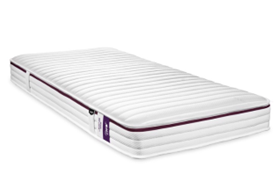
JAY-BE More Memory E-Pocket Single Mattress
Give your child the gift of a good night’s sleep with this eco-friendly, supportive, and comfortable mattress.
- E-Pocket Springs – To keep the body elevated and supported for a more restful night’s sleep.
- Medium Tension – Good all rounder for children who sleep on their front, side, or back.
- Free 5 year guarantee.
Types of mattresses for children
Please note – the mattresses listed below are aimed at children sleeping in single beds or larger, they are not suitable for babies. Babies need their own clear, flat, separate sleep space, such as a cot or Moses basket. The Lullaby Trust provide free mattress advice for babies.
Memory foam mattresses:
Memory foam mattresses are popular for contouring to the body, reducing tossing and turning. This provides pressure relief and support to children, helping them sleep better at night.
Here are some things to consider:
- Safety: While some cheaper memory foam mattresses may contain toxic flame retardants that can harm children, numerous high-quality memory foam bed options are entirely free of these harmful substances. This ensures that children can have a safe and healthy sleeping environment. Look for mattresses that are made from safe and non-toxic materials, such as certified organic cotton or natural latex.
- Support: While memory foam can provide good support, older children/teens may benefit from sleeping on a firmer mattress. A mattress that is too soft may not provide adequate support and can lead to back pain and other issues.
- Temperature Regulation: Some memory foam can retain heat, which can be uncomfortable for children who tend to sleep hot. Look for memory foam beds with temperature control or try latex or innerspring. Alternatively, use a cooling mattress protector.
- Durability: Memory foam mattresses can be durable and long-lasting but may not be as durable as traditional innerspring mattresses. This is especially important for children’s mattresses, which may need to withstand more wear and tear.
In summary, memory foam mattresses can be a good option for active kids, providing responsive support. Still, choosing a safe and non-toxic mattress that provides adequate support and is designed to regulate temperature is essential. Also, check if the bed is durable enough for rough usage.

Sweet Dreams Rosie Mattress
Let your child experience a cosy and snug sleep every night with Sweet Dreams’ Rosie mattress.
- Memory Foam – Moulds to the shape of your child’s body with a host of benefits from pressure relief to zero motion transfer.
- Soft to Medium Tension – Good for children who are side sleepers and require a little more support.
- Free 5 year warranty.

Relyon Harmony Mattress
The Relyon Harmony Mattress is a great choice for children who need a comfortable and restful night’s sleep.
- Memory Foam – Reacts to heat and pressure by moulding to your body shape for optimal support.
- Medium Tension – Good all rounder for children who sleep on their side, front and back.
- Free 5 year guarantee.
Pocket sprung mattresses:
Pocket spring mattresses can be a good option for children, providing good support and comfort. This type of mattress is more responsive to your child’s weight and movements than standard sprung mattresses.
Here are some benefits of pocket spring mattresses for children:
- Support: Pocket spring mattresses provide good support for children’s growing bodies. The springs work independently to support the body’s natural curves, which can help prevent back pain and other issues.
- Durability: Children need durable beds – pocket spring mattresses last longer than adults’.
- Comfort: Pocket spring mattresses can be comfortable for children, as they provide a combination of support and cushioning. The individual springs conform to the body’s shape, providing a comfortable sleeping surface.
- Temperature regulation: Pocket spring beds boost airflow, reducing heat and regulating temperature.
The best mattress for a child depends on their needs, preferences, and sleeping habits. It’s essential to choose a mattress that provides adequate support for your child’s growing body and is comfortable and durable. Also, choose safe mattresses like organic cotton or natural latex for your child’s health.

Millbrook Bamforth Superior Mattress
Let your child experience uninterrupted, rejuvenating sleep with the Bamforth Superior mattress, designed to provide ultimate comfort night after night.
- Individual Pocket Springs – Pocket springs to keep the body elevated and supported for a more restful night’s sleep.
- Medium Tension – Good all rounder for children who sleep on their front, side or back sleepers.
- Free 10 Year Warranty to provide you with peace of mind night after night.
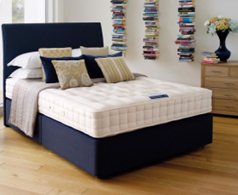
Hypnos Tranquil Comfort Mattress
The Hypnos Tranquil Comfort mattress is an excellent choice for children who need a peaceful and comfortable night’s sleep.
- ReActive Pocket spring to offer optimal support offering you a relaxing night’s sleep.
- Medium Tension – Good all rounder for children who sleep on their front, side, or back.
- 10 Year Guarantee to provide your child with the ultimate sleeping experience.
Traditional sprung mattresses:
Spring beds work well for children too, supporting the spine and promoting alignment.
Here are some benefits of traditional spring mattresses for children:
- Support: Traditional spring mattresses provide good support for children’s growing bodies. The coils work together to support the body’s natural curves, which can help prevent back pain and other issues.
- Durability: Traditional spring beds last and withstand wear better than adult ones, important for a child’s bed.
- Comfort: Traditional spring mattresses can be comfortable for children, as they provide a combination of support and cushioning. The coils conform to the body’s shape, providing a comfortable sleeping surface.
- Affordability: Spring beds are budget-friendly, a crucial factor for families.
Pick a spring bed for your child based on coil count, material quality, and firmness. It’s essential to choose a mattress that provides adequate support for your child’s growing body and is comfortable and durable. Additionally, opt for non-toxic beds such as organic cotton or natural latex for your child’s health.
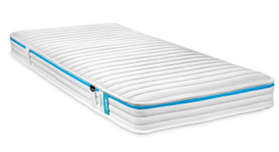
JAY-BE More Memory E-Spring Single Mattress
The Jay-Be More Memory E-Spring Mattress is an eco-friendly and supportive option for children’s beds.
- Memory E-fibre – For quick response to pressure relief.
- Medium to Firm Tension – Good for children and teens who change sleeping position.
- Free 5 year guarantee.
Latex mattresses:
Latex mattresses can be a good option for children’s mattresses, as they provide a combination of support, comfort, and durability. They are naturally hypoallergenic and breathable, perfect for children with allergies and those who like to stay cool at night.
Here are some benefits of latex mattresses for children:
- Support: Latex mattresses provide good support for children’s growing bodies. They conform to the body’s natural curves, giving help where it’s needed most.
- Comfort: Latex mattresses are comfortable and cushioning, which can help promote quality sleep. Children who sleep on a comfortable mattress are more likely to sleep soundly and wake up feeling rested.
- Durability: Durable latex mattresses are ideal for children’s beds as they can withstand wear and tear better than adult mattresses.
- Hypoallergenic: Latex mattresses are naturally hypoallergenic, which can benefit children with allergies or sensitivities to certain materials.
- Eco-friendly: Natural and eco-friendly materials used in latex mattresses make them a great choice for environmentally conscious families.
When selecting a latex mattress for your child, factors to consider include material quality, firmness level, and adherence to certifications and safety standards. It’s important to choose a mattress that provides adequate support for your child’s growing body and is comfortable and durable. Additionally, to safeguard your child’s health and well-being, prioritise mattresses made from certified organic cotton or natural latex that are free of harmful substances.
Foam mattresses:
Foam mattresses are a popular option for children’s mattresses, as they can provide a combination of support and comfort. Here are some benefits of foam mattresses for children:
- Support: Foam mattresses can provide good support for children’s growing bodies. They can conform to the body’s natural curves, giving help where it’s needed most.
- Comfort: Foam mattresses can be comfortable and cushioning, which can help promote quality sleep. Children who sleep on a comfortable mattress are more likely to sleep soundly and wake up feeling rested.
- Durability: Durable foam mattresses may endure more wear and tear than adult mattresses.
- Hypoallergenic: Foam mattresses can be naturally hypoallergenic or can be treated to be hypoallergenic, which can be beneficial for children who have allergies or sensitivities to certain materials.
- Variety: Foam mattresses come in various types and levels of firmness, allowing parents to choose a mattress that is appropriate for their child’s age and developmental stage.
Consider material quality, firmness level, certifications, and safety standards when selecting a foam mattress for your child. It’s important to choose a mattress that provides adequate support for your child’s growing body and is comfortable and durable. Choose mattresses made from certified organic cotton or natural latex to prioritise your child’s health and well-being.
Gel mattresses:
Gel mattresses are a newer type of mattress designed to provide a cooler sleeping surface, as the gel material helps dissipate body heat. While gel mattresses can be a good option for some adults, they may not be the best choice for children’s mattresses. Here are some considerations to keep in mind when it comes to gel mattresses and children:
- Firmness: Gel mattresses may not provide the same level of firmness and support that children need for proper spinal alignment. Gel mattresses may not offer the required level of support for growing children who require firm mattresses.
- Temperature regulation: Gel mattresses are made to provide a cool sleep surface, but this feature may not be as essential for children as it is for adults, as children are better at regulating their body temperature. Therefore, they may not need a mattress specially designed to keep them cool.
- Durability: As gel mattresses are a relatively new type, their long-term durability may not be as established as other mattress types. This can be a concern for children’s mattresses, which may need to withstand more wear and tear than adult mattresses.
- Cost: Gel mattresses can be pricier than other types and may not justify the added cost for a young child’s mattress that will require replacement as the child grows.
Gel mattresses may not be the ideal choice for children’s mattresses as they might not offer the necessary firmness and support required for proper spinal alignment. It is crucial to select a mattress that is suitable for your child’s age and developmental stage and provides sufficient support and comfort for their growing bodies.

Silentnight Layla Mattress
The Layla Mattress is an excellent option for children who need a breathable and supportive sleeping surface.
- Geltex® – A unique gel infused foam which provides a soft yet supportive feel whilst working to regulate your body temperature for a refreshing nights sleep
- Medium Tension – Good all rounder for children who sleep on their front, side, or back
- Free 5 Year Guarantee

Silentnight Alicia Mattress
The Alicia Mattress is a fantastic option for children who need a comfortable and allergy-friendly sleeping surface.
- Geltex® – A unique gel infused foam which provides a soft yet supportive feel whilst working to regulate your body temperature for a refreshing night’s sleep
- Medium Tension – Good for children who change sleeping position.
- Free 5 Year Guarantee
General buying tips when choosing a child’s mattress
To choose the right children’s mattress, it’s important to consider factors such as size, support, safety, materials, and longevity. Here are some tips to help you make an informed decision:
- Consider the size: Children’s mattresses come in various sizes, from cot mattresses to twin-sized mattresses. Consider your child’s age, size, and bed frame when choosing the appropriate mattress size.. Measure your child’s bed frame and select a mattress that fits snugly.
- Look for a supportive mattress: A good mattress should support your child’s spine and joints. Look for a mattress with a firm support system, such as pocket springs or high-density foam. This will help keep your child’s spine in a healthy alignment and prevent back pain.
- Check for safety features: Choose safe mattresses that meet British safety standards, including those with flame-retardant materials and hypoallergenic covers.
- Consider the materials: Children’s mattresses can be made from various materials, including foam, latex, and springs. Each material has its benefits and drawbacks, so do your research to find the best fit for your child. For example, foam mattresses are lightweight and affordable but may not provide as much support as spring mattresses.
- Think about longevity: Children grow quickly, so choosing a mattress that will last through their growth spurts is essential. Look for high-quality mattresses that will withstand wear and tear, and consider investing in a mattress with an extended warranty.
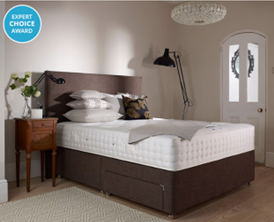
Relyon Kingsley Mattress
The Kingsley mattress is a great option for teenagers who need a comfortable and supportive sleeping surface.
- Pocket springs that adapt to your individual sleeping position to offer supreme support.
- Medium Tension – Good for teenagers who change sleeping position.
- Free 8 year guarantee.
FAQ about children’s mattresses
How firm should a child’s mattress be?
Choosing a mattress with the right level of firmness is crucial for providing optimal support for a child’s developing body.
Here are some guidelines for choosing the right level of firmness for your child’s mattress:
- Babies: A firm, flatt mattress
- Pre-schoolers: As pre-schoolers become more active, they may benefit from a softer mattress that allows for better pressure relief. However, the mattress should still provide adequate support to prevent back pain and other issues.
- School-aged children: School-aged children need a mattress that provides good support and is comfortable enough to promote quality sleep (e.g. medium). The mattress should provide adequate support for the child’s growing body without being uncomfortable.
- Adolescents: Adolescents need a mattress that supports their growing bodies. A medium to firm mattress can be a good option for adolescents, providing both support and comfort.
A child’s mattress firmness should match their age and development. Ensure you choose a comfortable and sleep-promoting mattress.
Can a mattress affect a child’s spine?
Choosing the right mattress for your child is vital for their spinal health. A supportive, comfortable, and firm mattress can promote proper spinal alignment, prevent back pain, and other spinal issues. Choose a mattress suitable for your child’s age, developmental stage, and made from safe and non-toxic materials to ensure their overall well-being.
How much should I spend on a child’s mattress?
Prices for mattresses can range from under £100 to several thousands. It’s important to remember that you get what you pay for in terms of both product and service. Investing as much as you can afford in a high-quality children’s mattress is essential for comfort, support, and a good night’s sleep. With a mattress being used daily for many hours, it’s worth prioritising quality and comfort. “Buy cheap, buy twice” should be remembered when purchasing a children’s mattress, as spending more upfront can save money in the long term while benefiting your child’s overall health and well-being. It’s generally true that higher-priced mattresses have better-quality materials and longer lifespans, so it’s worth investing in your child’s sleeping environment. We advise spending as much as you can realistically afford. We have a range of payment options available to help with your purchase.
What age should children start sleeping in a bed?
The recommended age for transitioning a child from a cot to a bed varies based on their size, development, readiness and space available in the bedroom. Consider your child’s individual needs and developmental stage to make a safe and comfortable transition.
Is co-sleeping with a child safe?
Co-sleeping with a child can be safe if certain precautions are taken, such as ensuring a separate sleep surface for the child, avoiding soft bedding or pillows near the child, and not allowing the child to be smothered by blankets or other objects. However, it’s important to note that co-sleeping may not be safe for all families, particularly if the parent is under the influence of drugs or alcohol or if the child has certain health conditions. It’s always best to consult with a healthcare provider and follow safe sleep guidelines when considering co-sleeping with a child.
When considering whether it is safe to co-sleep with your baby, it is important to remember that a recent report from the National Child Mortality Database revealed that many babies die in dangerous co-sleeping situations, often unplanned. To reduce the risk of sudden infant death syndrome (SIDS), the safest sleep environment for babies is a separate, flat, and clear sleep space.
What size mattress do you recommend for children?
The size of the mattress recommended for children in the UK depends on their age and size. Here are some general guidelines:
- Cot mattresses: A cot mattress is typically 28 inches wide and 52 inches long for infants and toddlers.
- Toddler mattresses: A toddler mattress may be used once a child outgrows a cot. These are typically 27 inches wide and 52 inches long.
- Small single mattresses: Those transitioning from a cot bed often start off in a small single. This measures 90 x 190cm.
- Single mattresses: Children may require a larger mattress as they age and grow. A standard single mattress in the UK is 90cm wide and 190 cm long.
- Small double mattresses: A small double mattress may be suitable for older children or teenagers who want a bit more space to stretch out. These are typically 120cm wide and 190cm long.
Ultimately, the size of the mattress you choose for your child should be based on their individual needs and preferences and the size of their room and bed frame. Choosing a mattress that provides adequate support and comfort for your child’s growing body and meets all safety standards and regulations is essential.
What is the best children’s mattress?
When it comes to choosing the ‘best’ children’s mattress, it’s essential to consider your child’s unique needs and preferences. Conducting thorough research and selecting a mattress that offers optimal support, comfort, and safety for your child’s development is crucial. Our team of bed experts is available to help you make an informed decision. Whether you prefer to call, visit, or click, we are happy to address any concerns or questions you may have.
How often should I replace my child’s mattress?
The frequency of replacing your child’s mattress depends on various factors, such as age, quality, maintenance, and usage, and it’s important to take into account your child’s growth and development. While the general recommendation for replacing mattresses is every 7-8 years, it’s advisable to replace them more often for children. Typically, children aged 3-10 years require a new mattress every three years, while those aged 10-16 years need one every five years. However, some mattresses may need replacing sooner due to wear and tear.
How do I know if my child’s mattress needs replacing?
Here are some signs that it may be time to replace your child’s mattress:
- Sagging or lumps: If the mattress has visible dips or sagging areas or feels lumpy or uneven, it may no longer provide the necessary support for your child’s growing body.
- Wear and tear: It may be time for a replacement if the mattress has visible signs of wear and tear, such as frayed edges or tears in the fabric.
- Allergies or respiratory problems: If your child experiences allergies or respiratory issues, it may be a sign that the mattress harbours allergens or other irritants, and a replacement may be necessary.
- Changes in sleep patterns: If your child is having trouble sleeping, experiencing discomfort or pain, or waking up frequently at night, it may be a sign that the mattress no longer provides the necessary support and comfort.
- Growth spurts: As your child grows and their body changes, they may need a new mattress to provide the proper support and comfort for their evolving needs.
To extend the lifespan of your child’s mattress, it’s worth investing in a mattress protector to prevent spills, stains, and allergens from accumulating. This can help maintain the mattress quality and hygiene, ensuring a comfortable and healthy sleeping environment.
Can my child use a second-hand mattress?
Although it is possible to use a second hand mattress, it is generally not recommended as a long term solution. While it may seem like a cost-effective option, there are several reasons why it’s best to purchase new when possible:
- Hygiene: A second-hand mattress may have accumulated dust, dirt, and other allergens, which can trigger respiratory problems and allergies in children.
- Wear and tear: A used mattress may have lost its shape and support over time, which can cause discomfort and contribute to poor sleep quality.
- Bed bugs and other pests: Second-hand mattresses may harbour bed bugs, dust mites, or other pests, which can infest your child’s sleeping environment.
- Safety concerns: A used mattress may have been exposed to damage, such as tears or holes, which can create a safety hazard for your child.
To ensure your child’s safety, comfort, and health, it’s advisable to buy a new mattress that meets safety standards and regulations. However, if you opt for a second-hand mattress, carefully examine it for signs of damage, pests, or any other problems before using it.
How do I care for my child’s mattress?
To preserve the life of your child’s mattress, we strongly recommend using a mattress protector.
Do children’s mattresses need to be fire retardant?
All mattresses sold in the UK must pass fire safety tests under the Furniture and Furnishings (Fire) (Safety) Regulations 1988 (as amended in 1989, 1993, and 2010). Some manufacturers may also use fire retardant materials or treatments to enhance the mattress’s fire resistance further. When purchasing a child’s mattress, choosing a trustworthy brand with a proven safety and quality record that adheres to all fire safety regulations and standards is essential.
At what age can children use high sleeper beds?
High sleepers/loft beds are generally suitable for those aged six years and older. Our high beds have all undergone rigorous safety testing to ensure they meet child safety regulations. They are compatible with standard single mattresses no more than 18cm deep, so the guard rails remain at a safe height. It’s always a good idea to check the bed and mattress specifications to ensure they are suitable for your child. Our bed experts can recommend further.
High sleeper beds are particularly popular with pre-teens and teenagers, who appreciate the extra space underneath. They typically range from 175 cm to 190 cm in height and come with a ladder. Before buying a high sleeper bed, it’s essential to ensure your child can safely climb up and down and sit straight in bed without touching the ceiling.
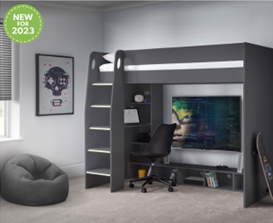
Land of Beds Flynn Anthracite High Sleeper
The Flynn Anthracite High Sleeper is the ultimate gaming setup for kids and teens.
- Wooden Slatted Base – This system has the benefit of allowing air to move below the mattress and therefore lets it breathe giving you a comfortable night’s sleep.
- Accepts a Standard UK Single Mattress (90cm x 190cm).
- A perfect gaming setup! With a large wall space for a TV, desk, and shelves, as well as glow in the dark ladder strips.
- Made from Wood Effect.
If you’re worried about changing the sheets on a high sleeper, we have a range of space-saving options such as mid-sleeper beds, cabin beds, and bunk beds with built-in storage.
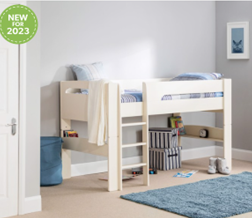
Land of Beds Bruno White Mid Sleeper Single Children’s Bed
Finished in a smooth stone white lacquer, the Land of Beds Bruno white mid sleeper offers excellent functionality with a robust ladder that can be assembled on either side and the option to convert to a single bed in the future.
- Wooden Slatted Base – This system has the benefit of allowing air to move below the mattress and therefore lets it breathe giving you a comfortable night’s sleep.
- Accepts a Standard UK Single Mattress (90cm x 190cm).
- Versatile build which can be customised with a pink or blue star tent and can also be transformed into a standard single frame when required.
- Made from Solid Pine and Wood Effect.
Can I use any mattress on bunk beds?
If using a bunk bed, cabin/mid sleeper or guest bed, the mattress depth must be no greater than 18cm / 7”.
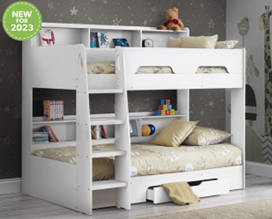
Land of Beds Kingsbury White Single Bunk Bed
The Kingsbury Pure White Bunk Bed is a dazzling choice for children seeking an exciting and comfortable sleeping option.
- Wooden Slatted Base – This system has the benefit of allowing air to move below the mattress and therefore lets it breathe giving you a comfortable night’s sleep.
- The lower bunk is positioned close to the ground, making it ideal for smaller children, while the robust ladder features attractive cut-out handles and stick on glow-in-the dark strips.
- Accepts 2 Standard UK Single Mattresses (90cm x 190cm).
- Made from Wood Effect
Can I get children’s beds on finance?
We offer various finance options to help make your child’s new bed/mattress a reality. Applications take approximately ten minutes and can be completed online, in-store or over the telephone.
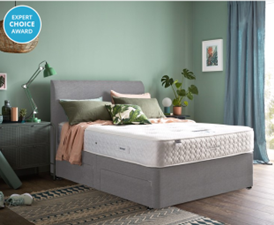
Silentnight Amelia Mattress
The Amelia mattress is an excellent choice for children who need a supportive and eco-friendly sleeping surface.
- Mirapocket Spring System – Unique to Silentnight, these springs evenly distribute your weight for supreme support and excellent spinal alignment
- Medium to Firm Tension – Good for children who change their sleeping position
- Free 5 Year Guarantee
Free, independent, expert advice!
Our team of award-winning bed experts are on hand to help you find the right bed/mattress for your child. Give them a call today on 01928 242829 or email sales@landofbeds.co.uk Alternatively, use the chat feature on our website. Our staff are ready to share their knowledge and their outstanding customer service skills come as standard!

